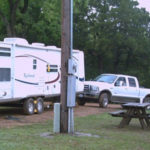WACO—Chase Oaks Church in Plano and LifeBridge Christian Church in Longmont, Colo., minister 817 miles apart. But they stand side-by-side in their response a devastating question-and-answer.
Q: If their church evaporated, would anybody outside the church notice?
A: Probably not.
|
Eric Swanson of the Leadership Network discusses the characteristics of externally focused churches with participants at The Next Big Idea Conference at Baylor University. (BAYLOR PHOTOGRAPHY/Robert Rogers)
|
Glen Brechner, pastor of leadership at Chase Oaks, and Rick Rusaw, senior minister at LifeBridge, acknowledged the pain of that answer. But they told participants at the Next Big Idea Conference at Baylor University their response also revolutionized their churches.
Baylor’s Truett Theological Seminary , the Baylor School of Social Work and the Leadership Network sponsored the conference on the Baylor campus Feb. 9-11. It brought church leaders and academic researchers together to discuss how congregations could make a difference in their communities.
Both Chase Oaks and LifeBridge were successful churches by conventional standards, Brechner and Rusaw recalled. They enjoyed vibrant worship, pulled members together into meaningful small groups, and operated a plethora of programs.
“But we were an internally focused church,” Brechner acknowledged. “We had lots of programs. We were a really busy church. Our church was healthy, … but so focused on the church that it did not effectively reach the community and meet community needs.”
Leaders at LifeBridge had a hunch they were in the same predicament. That prompted them to pose the question that became “the turning point for our church,” Rusaw reported. “We asked, ‘If our church disappeared, would anybody miss us?’”
The realization that they made little impact outside their own membership alarmed leaders at both churches, Brechner and Rusaw said. So, both congregations decided they must serve others—for the very existence of the churches, the benefit of their communities and the fulfillment of God’s kingdom.
Sign up for our weekly edition and get all our headlines in your inbox on Thursdays
Their response places them within an emerging trend, noted Eric Swanson, a staff member of Leadership Network who works with “externally focused” churches.
“God is taking the church and placing it back in the community,” where it can make a difference in the lives of all kinds of people, Swanson observed.
Churches exist in a context that involves three key variables, he said. They are the needs and dreams of the city, the callings and capacities of the church, and the mandates and desires of God. Service is the “sweet spot” where all three of those variables intersect, he added.

Rick Rusaw, senior minister at LifeBridge Christian Church in Longmont, Colo., told participants at The Next Big Idea conference how his congregation reached a turning point by asking, “If our church disappeared, would anybody miss us?” (BAYLOR PHOTOGRAPHY/Matthew Minard)
|
The place where the interests of the church and God overlap is where salvation takes place, where individuals come to know Jesus as their Savior, he said. And the place where the mandates of God and the needs of the city overlap is called “common grace”—where the overall welfare of the community is served, such as police and fire protection.
To illustrate those two areas of overlap, Swanson cited 16th century church reformer John Calvin, who observed: We pay taxes to provide for common grace, and we pay our tithes to support saving grace.
The point of overlap exclusively between church and city is a sensitive zone, where struggle for control can exist, Swanson said. This is why separation of church and state is important, so that one does not dominate the other, he added.
But the “sweet spot”—the place in the middle, where God’s mandates, the city’s dreams and the church’s capabilities all intersect—is service, Swanson said.
“That’s where churches serve and bless their cities,” he noted. Churches’ ministry to the needs of people in the community achieves “the things God wants, the city wants and the churches can do.”
The trend toward service is bubbling up from within churches, explained Diana Garland, dean of the Baylor School of Social Work, and a prolific researcher of American church life.
The Church Census, which studied more than 100 congregations across 15 years, asked families to tell how their church can help them, offering almost 50 options from a variety of aspects of family life, she said.
“Help in serving others outside our family” was the No. 1 request in every age category, except for couples in their 20s and 30s, whose greatest desire is help for developing strong marriages, Garland said. And even for those younger adults, “serving others outside our family” ranked second.
That strong desire to serve others transcends family types, from families headed by married couples, to remarried couples and divorced singles, she said.
“The most interesting challenge for the church is to offer guidance and support for families … that are grounded in the beliefs and values of the Christian faith,” Garland said. “Only the church can ground these life issues in Christian values and practices. … These families are asking their churches to ground their service in Christian mission.”
That’s exactly the track taken by Chase Oaks and LifeBridge churches.
LifeBridge’s mission is to “help people know Christ, grow in Christ and live gracefully,” Rusaw said. Chase Oaks disbanded most of its programs and focused members on “connecting to God, connecting to people and connecting to need,” Brechner added.
Both congregations re-tooled their standards for members, stipulating they are expected to attend worship (LifeBridge’s “know Christ” and Chase Oaks’ “connecting to God”), participate in small groups that study the Bible (“grow in Christ”/“connecting to people”) and serve others (“live gracefully”/“connecting to need”).
But service transcends the categories, Rusaw indicated, noting, “We believe you grow best when you serve.”
Chase Oaks conducts four churchwide ministry projects per year. But it also serves on a smaller, more direct and more continuous scale, Brechner said. Each adult life group is expected to have a “bridge”—an ongoing human-needs ministry in the community. During every fourth meeting, each life group meets at its bridge and serves non-members in the community.
Similarly, LifeBridge has linked its small groups with 54 partner organizations in its community—from schools, to nonprofit groups and other social-service organizations.
In fact, LifeBridge intentionally avoids starting ministries, because that would waste resources and pass up opportunities to build relationships outside the church, Rusaw said.
“We won’t start something that already exists,” he said. “The church has one thing that every agency in your community needs—people. They need volunteers. So, the church is not the competition (to nonprofits, schools and social-service groups). Partner where you can partner.”
Often, the church’s service not only meets the felt needs of the community, but it also reaches deeper to transform lives. For example, through LifeBridge’s service in public schools, hundreds of teachers and coaches and administrators have come to faith in Christ, Rusaw reported.
That relates to something Swanson has seen as he’s worked with externally focused churches: Good deeds prepare the way for people to hear the good news of Christ.
But externally focused, service-oriented churches are, like Christ, committed to meet people’s needs, whether or not they respond spiritually, he noted.
“Evangelism is or ultimate motive, not our ulterior motive,” he said. “We always want people to come to Christ, but even if no one comes to Christ, we’ll still keep doing these acts of service.”
So, service improves lives, strengthens churches and changes communities, Swanson said.
Referencing Jesus’ Great Commandment, he added: “Spiritual transformation occurs when people are loving God with all their heart, soul, mind and strength. Societal transformation occurs when people are loving their neighbors as themselves.”














We seek to connect God’s story and God’s people around the world. To learn more about God’s story, click here.
Send comments and feedback to Eric Black, our editor. For comments to be published, please specify “letter to the editor.” Maximum length for publication is 300 words.